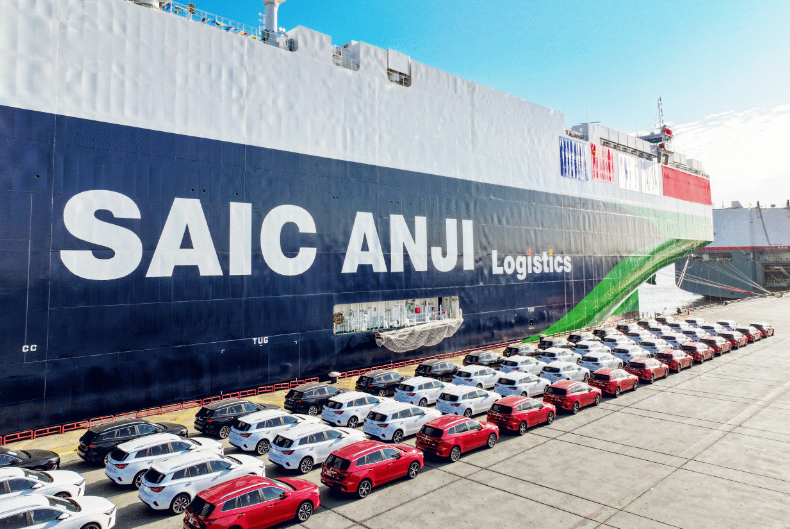In recent years, China's automobile exports have continued to hit new highs. In 2023, China will surpass Japan and become the world's largest automobile exporter with an export volume of 4.91 million vehicles. As of July this year, my country's cumulative export volume of automobiles has reached 3.262 million units, a year-on-year increase of 28.8%. It continues to maintain its growth momentum and firmly ranks as the world's largest exporting country.
my country's automobile exports are dominated by passenger cars. The cumulative export volume in the first seven months was 2.738 million units, accounting for 84% of the total, maintaining a double-digit growth of more than 30%.

In terms of power type, traditional fuel vehicles are still the main force in exports. In the first seven months, the cumulative export volume was 2.554 million vehicles, a year-on-year increase of 34.6%. In contrast, the cumulative export volume of new energy vehicles during the same period was 708,000 units, a year-on-year increase of 11.4%. The growth rate slowed down significantly, and its contribution to overall automobile exports decreased.
It is worth noting that in 2023 and before, new energy vehicles have been the main force driving my country's automobile exports. In 2023, my country's automobile exports will be 4.91 million units, a year-on-year increase of 57.9%, which is higher than the growth rate of fuel vehicles, mainly due to the 77.6% year-on-year growth of new energy vehicles. Dating back to 2020, new energy vehicle exports have maintained a growth rate of more than double, with annual export volume jumping from less than 100,000 vehicles to 680,000 vehicles in 2022.
However, the growth rate of new energy vehicle exports has slowed this year, which has affected my country's overall automobile export performance. Although the overall export volume still increased by nearly 30% year-on-year, it showed a downward trend month-on-month. July data show that my country's automobile exports increased by 19.6% year-on-year and decreased by 3.2% month-on-month.
Specific to new energy vehicles, although export volume maintained a double-digit growth of 11% in the first seven months of this year, it fell sharply compared to the 1.5-fold increase in the same period last year. In just one year, my country's new energy vehicle exports have faced such huge changes. Why?
Exports of new energy vehicles slow down
In July this year, my country's new energy vehicle exports reached 103,000 units, a year-on-year increase of only 2.2%, and the growth rate further slowed down. In comparison, most of the monthly export volumes before June still maintained a year-on-year growth rate of more than 10%. However, the doubling growth trend of monthly sales that was common last year has no longer reappeared.
The formation of this phenomenon stems from many factors. First of all, the significant increase in the export base of new energy vehicles has affected the growth performance. In 2020, my country's new energy vehicle export volume will be about 100,000 units. The base is small and the growth rate is easy to highlight. By 2023, export volume has jumped to 1.203 million vehicles. The expansion of the base makes it difficult to maintain high growth rate, and the slowdown in growth rate is also reasonable.
Secondly, changes in the policies of major exporting countries have affected my country's new energy vehicle exports.
According to data from the General Administration of Customs, Brazil, Belgium, and the United Kingdom were the top three exporters of new energy vehicles in my country in the first half of this year. In addition, European countries such as Spain and Germany are also important markets for my country's new energy exports. Last year, my country’s sales of new energy vehicles exported to Europe accounted for about 40% of the total. However, this year, sales in EU member states generally showed a downward trend, falling to about 30%.
The key factor causing this situation is the EU's countervailing investigation into my country's imported electric vehicles. Starting from July 5, the EU will impose temporary tariffs of 17.4% to 37.6% on imported pure electric vehicles from China on the basis of the 10% standard tariff, with a tentative period of 4 months. This policy directly led to a sharp decline in China's electric vehicle sales exported to Europe, which in turn affected the overall export performance.
Plug-in hybrid into new engine for growth
Although my country's pure electric vehicles have achieved double-digit growth in Asia, South America and North America, the overall export of pure electric vehicles has shown a downward trend due to the sharp decline in sales in European and Oceanian markets.
Data show that in the first half of 2024, my country's exports of pure electric vehicles to Europe were 303,000 units, a year-on-year decrease of 16%; exports to Oceania were 43,000 units, a year-on-year decrease of 19%. The downward trend in these two major markets continues to expand. Affected by this, my country's pure electric vehicle exports have declined for four consecutive months since March, with the decline expanding from 2.4% to 16.7%.
The overall export of new energy vehicles in the first seven months still maintained double-digit growth, mainly due to the strong performance of plug-in hybrid (plug-in hybrid) models. In July, the export volume of plug-in hybrids reached 27,000 vehicles, a year-on-year increase of 1.9 times; the cumulative export volume in the first seven months was 154,000 vehicles, a year-on-year increase of 1.8 times.
The proportion of plug-in hybrids in new energy vehicle exports jumped from 8% last year to 22%, gradually replacing pure electric vehicles as the main growth driver of new energy vehicle exports.
Plug-in hybrid models are showing rapid growth in many regions. In the first half of the year, exports to Asia were 36,000 vehicles, a year-on-year increase of 2.9 times; to South America were 69,000 vehicles, an increase of 3.2 times; to North America were 21,000 vehicles, a year-on-year increase of 11.6 times. Strong growth in these regions effectively offset the impact of declines in Europe and Oceania.
The sales growth of Chinese plug-in hybrid products in many markets around the world is closely related to their excellent cost performance and practicality. Compared with pure electric models, plug-in hybrid models have lower vehicle manufacturing costs, and the advantages of being able to use both oil and electricity enable them to cover more vehicle use scenarios.
The industry generally believes that hybrid technology has broad prospects in the global new energy market and is expected to keep pace with pure electric vehicles and become the backbone of China's new energy vehicle exports.
Post time: Aug-13-2024


